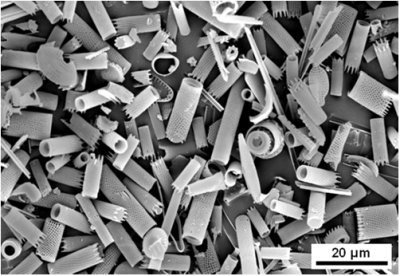Diatoms
 Diatoms (algae, Division Bacillariophyta) are unicellular, eukaryotic organisms characterised by their siliceous cells, each consisting of two intricately patterned 'thecae'. Diatoms occur throughout the world, growing in almost all aquatic environments. They are highly sensitive to a broad range of environmental factors (including water depth, water quality, temperature and salinity), however, with different taxa capable of tolerating different ranges of these environmental conditions.
Diatoms (algae, Division Bacillariophyta) are unicellular, eukaryotic organisms characterised by their siliceous cells, each consisting of two intricately patterned 'thecae'. Diatoms occur throughout the world, growing in almost all aquatic environments. They are highly sensitive to a broad range of environmental factors (including water depth, water quality, temperature and salinity), however, with different taxa capable of tolerating different ranges of these environmental conditions.
The characteristic valve morphology of diatoms allows the identification of most fossil taxa to the species level. This facilitates the characterisation of fossil diatom assemblages, which can, in turn, be used to reconstruct past ecological, environmental, and climatic information about the site, based upon knowledge of the tolerance ranges of the contributory taxa from comparative modern data ('training sets').
The annually laminated (varved) Lake Suigetsu sediment profile is extremely rich in diatoms, and thus lends itself to high-resolution diatom analysis and diatom-based environmental reconstructions. Through examination of the diatom assemblages across a range of depth horizons down the sediment profile, ecological, environmental, and climatic changes through time can be reconstructed.
Diatom analyses from the SG06 sediment core are being undertaken at both the Department of Earth Sciences, Freie Universität Berlin and the National Museum of Nature and Science, Tokyo.
Publications
Previous diatom-based studies at Lake Suigetsu include those of:
Recently, Kossler et al. (2011) have published the first diatom-based article stemming from the "Suigetsu Varves 2006" project, which is entitled, "Onset and termination of the late-glacial climate reversal in the high resolution diatom and sedimentary records from the annually laminated SG06 core from Lake Suigetsu, Japan". This paper presented results of high-resolution (~5 years, on average) diatom and sediment analyses on two portions of the SG06 sediment core, which are attributed, respectively, to the onset and the termination of the Younger Dryas (YD)-like climate reversal in central Japan.
 Diatoms (algae, Division Bacillariophyta) are unicellular, eukaryotic organisms characterised by their siliceous cells, each consisting of two intricately patterned 'thecae'. Diatoms occur throughout the world, growing in almost all aquatic environments. They are highly sensitive to a broad range of environmental factors (including water depth, water quality, temperature and salinity), however, with different taxa capable of tolerating different ranges of these environmental conditions.
Diatoms (algae, Division Bacillariophyta) are unicellular, eukaryotic organisms characterised by their siliceous cells, each consisting of two intricately patterned 'thecae'. Diatoms occur throughout the world, growing in almost all aquatic environments. They are highly sensitive to a broad range of environmental factors (including water depth, water quality, temperature and salinity), however, with different taxa capable of tolerating different ranges of these environmental conditions.